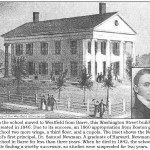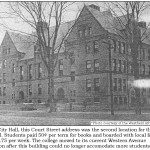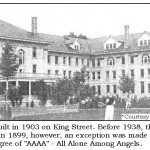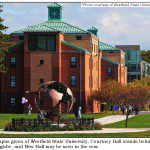June 21st, 1892: The Dedicatory and Triennial ceremony took place to celebrate the opening of the new Westfield Normal School at 59 Court Street. Commencement was held on this day, and many prominent state officials and alumni attended. This was the school’s third address after it moved from Washington Street. Its first location was in Barre, Massachusetts, but due to a lack of popularity and educational discipline, it was moved to Westfield in 1844. The institution was established by Horace Mann in 1838 and is now known as Westfield State University.
Several people were instrumental in organizing the school, especially where funding was concerned. When the Massachusetts Board of Education formed in 1837, Horace Mann served as its first secretary. To provide funding for the school, a member named Edmund Dwight approached Mann with a promise of $10,000 of his own money if the state legislature would also meet that figure. All parties were in agreement, and on April 19th, 1838, Governor Edward Everett approved the funds to form three state normal schools.
The school in Barre was established along with two others: one in Lexington (now Framingham State University) and another in Bridgewater. The Barre Normal School allowed both men and women to attend. Administrators were not experiencing as much success as they originally planned—after it opened, instruction began to dwindle in quality after the death of the school’s first principal, Dr. Samuel Newman. When it was moved to Westfield in 1844, it began to grow more popular. Emerson Davis was chosen as the principal, and William Clough was his assistant.
In early September of 1844, forty-nine men and women sought admission to the school, and only thirteen were from Westfield. After their entrance exams were completed, Davis and other administrators discovered that they were relatively unskilled. The highest scores from men and women were 66 % and 75% respectively. In recording personal information, it was discovered that thirty-two of the students were the children of farmers. During this time, however, about 70% of students already had teaching experience.
Although no one failed the exams, each applicant appeared to lack the expertise needed for higher learning. This seemed to mirror the type of issues seen when the school was in Barre. The way Davis and Clough conducted the academy was of little help. It was informal in nature, with Rev. Davis appearing for a short amount of time each day to lecture the students on whatever captured his interest. Clough served as the main instructor most of the time.
As time passed, the school adopted a stricter doctrine as admissions continued to grow. By the mid-1850s, there were approximately 260 students at the school. Around this time, John W. Dickinson began serving as the school’s principal. Now regarded as one of the architects of American pedagogy, Dickinson believed in not only educating students, but also studying the art of education itself. With this innovative attitude, students requested more advanced classes, and by 1858 a course was created for graduates. This addition would lead the school to transform into a four-year college in the early 1930s.
Since this era, the Normal School continued to adapt to the changing nation. The effects of World War II threatened the school’s closure, but it was eventually saved due to the town’s support. The state legislature would appropriate $3 million to build a new normal school in Westfield. The city donated 30 acres of land for the campus, and by 1956 the Westfield State Teacher’s College opened at its current address on Western Avenue. This is also the year the college gained accreditation from the New England Association of Colleges and Secondary Schools as well as the National Council for Accreditation of Teacher Education.
The name of the school would be changed to Westfield State College in the late 1960s. The school gained the ability to grant bachelor’s degrees in areas other than education in the early 1960s, and the change celebrated the school’s growth from a singular college for teachers. It was changed once more in recent years. In July of 2010, all six of Massachusetts’ state colleges were officially renamed as universities.
Westfield State University continues to grow today. There are about 4,500 undergraduate students attending in addition to the 1,000 who study as graduate and continuing education students. 2012 marks the university’s 174th anniversary.
WESTFIELD NEWS (Continued)
June 17th, 1871: Woronoco Savings Bank was chartered.
June 23rd, 1902: President Theodore Roosevelt visited Westfield.





